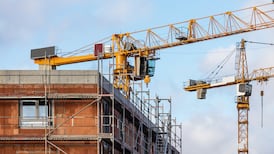Price growth in the State’s housing market continues to slow in the face of higher borrowing costs and wider inflationary pressures. Will it turn negative? There’s mounting evidence that it will. Daft.ie’s latest housing market report indicates that asking prices, as distinct from actual prices paid, fell in the first quarter of 2023, the first such decline in a decade.
The firm said asking prices across the State were down 0.3 per cent, with this drop extending to 0.4 per cent in Dublin. The average asking price was put at €308,497. This was still up 2.7 per cent on the same period last year but on a quarterly basis prices are falling. The figures come on the back of the latest Residential Property Price Index from the Central Statistics Office, which is based on actual transactions. It shows that prices on a monthly basis fell by 0.6 per cent in January, anchoring the annual rate of inflation to 6.1 per cent.


Property markets across the globe have gone into reverse on the back of an aggressive sequence of interest rate hikes by central banks. The fact that house price inflation – at least on an annual basis – remains positive here is a reflection of three things: strong population growth (a key driver of housing demand); chronic undersupply (Daft.ie said there were just 13,000 properties available to buy across the State on its website as of March 1st last); and, finally, the more muted pass through of higher interest rates, in other words banks here not hiking up mortgage rates as much as their counterparts in other countries.
The impact of higher interest rates has been somewhat softened, with lenders only partially passing on the latest European Central Bank rate increases, Conor O’Toole of the Economic and Social Research Institute (ESRI) said on Tuesday as the institute published its latest quarterly report. He noted that this could change if higher interest rates were maintained.
Renters forking out €2,000 per month are paying the price for water charges debacle
Hitting target of 41,000 homes to be built this year will be ‘challenging’, Minister for Housing admits
Holiday homeowners underestimate at their peril the anger among those locked out of the housing market
Water utility warns on reforms needed for housing targets: ‘The scale of the task is immense’
The industry insists the issues around supply and demand will outweigh the dampening effects of higher interest rates and price growth – on an annual basis – will stay positive. This would see the Republic avoiding the downturn in prices seen in other countries.
Others, such as Daragh Cassidy of price comparison website Bonkers.ie, however, suggest this is “wildly optimistic” and we will almost definitely see a reversal of some sort.
His rationale is that those borrowing €300,000 over 30 years on a mortgage rate of about 2 per cent – a rate available at the beginning of last year – would have had a monthly repayment of €1,109 a month. If the ECB hikes to 3.75 or 4 per cent, the best rate on the market by the end of the year will be around 5 per cent. To keep the same monthly repayment, either the amount borrowed or property prices would need to fall by about 30 per cent.
He says that strain on affordability will outweigh the current demand-supply dynamic and lead to falling prices later this year.


















